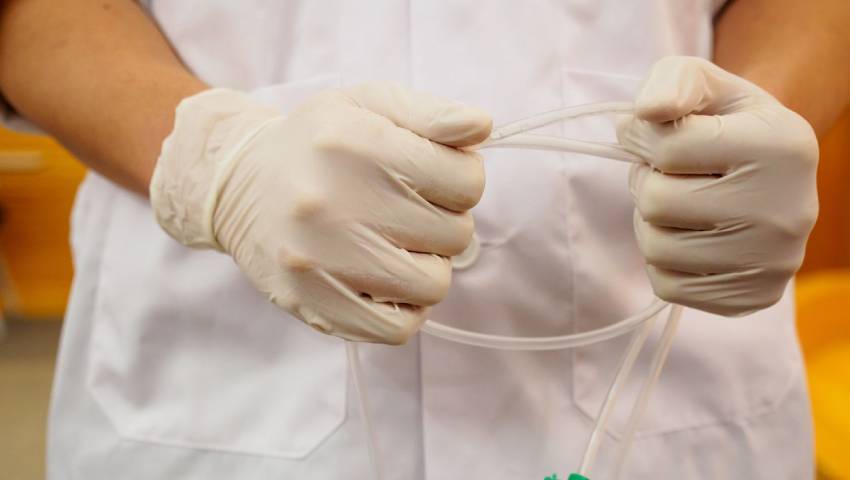
- 12/02/2024
- Dr. Pratik Patil
- 0 Comments
- Blog
Feeding tubes What Cancer patients and care givers should know
Maintaining proper nutrition during cancer treatment is important. When cancer patients struggle with this, a feeding tube can be a solution. These flexible plastic tubes placed in the stomach can help provide the calories, protein, vitamins, minerals and fluids needed to help the body fight infection, heal and stay healthy – all crucial during cancer treatment.
But the idea of a feeding tube can be daunting. Even though a feeding tube may be essential for helping you maintain a healthy, active life during and after cancer treatment, it can be a big lifestyle change. In this Blog, Dr. Pratik Patil – a Cancer Specialist In Pune explains What cancer patients and caregivers should know.
When do cancer patients need a feeding tube?
According to Dr. Pratik Patil, a Best Oncologist in Pune, cancer patients may require a feeding tube if they face difficulties in swallowing, particularly due to cancer in the head or neck area.
Additionally, patients who are malnourished before or during cancer treatment, which includes surgery, chemotherapy, and radiation therapy, may also benefit from a feeding tube. In some cases, patients who have fistulas, an opening, or an abscess in the esophagus or stomach may also require a feeding tube to ensure proper nutrition during cancer treatment.
How is a feeding tube inserted?
The way a feeding tube is placed depends on the type of feeding tube you need. There are three types of feeding tubes commonly used:
- Nasogastric tube (NG-tube): This flexible tube is passed through the nose, down the esophagus and into the stomach. It is placed at the patient’s bedside in the hospital and doesn’t require a surgical procedure. It is often temporary and given to patients who can’t eat for a short period following surgery.
- Gastrostomy tube (G-tube): This tube is inserted through the belly and brings food directly to the stomach. It can be placed during an outpatient procedure and does not require the patient to stay overnight. This tube is often used when patients will need to rely on a feeding tube for about three to four months or longer. It’s very easy to use.
- Jejunostomy tube (J-tube): A J-tube is a soft, plastic tube placed through the skin of the belly into the midsection of the small intestine. It can be placed as an inpatient or outpatient procedure. The tube delivers food and medicine until the person is healthy enough to eat by mouth. It bypasses the stomach completely and is often used when the patient cannot digest food in the stomach, like in some cases of stomach cancer. This tube is also best suited for long-term use.
Will patients feel their feeding tubes?
Again, this depends on the type of tube. Patients typically can feel an NG tube, but the good news is, it’s only used for a few days or weeks.
With longer-term tubes, like G-tubes and J-tubes, patients may experience some initial pain and discomfort, but it should fade after a day or two.
How do feeding tubes work?
Different tubes work in different ways. Some use a pump – typically formula. Others rely on gravity or a syringe to push the food. Your care team will teach you how to use your specific feeding tube.
Can patients operate feeding tubes by themselves?
Yes, all three types of the common feeding tubes mentioned above can be operated by the patients themselves. But depending on their physical and mental health, they may need help from a caregiver or health care provider. Dr Pratik Patil , we provide classes for patients and caregivers to prepare them to use feeding tubes
Are there any side effects from using a feeding tube?
Usually, there are no side effects from the tube itself. Some patients may experience some nausea, vomiting or diarrhea, but this can be addressed by adjusting how much formula is given and how much time the feeding takes. If these side effects continue, your doctor can prescribe anti-nausea medicine. It’s also important to properly clean the feeding tube and the area surrounding it as instructed by your care team. Otherwise, the patient is at risk of infection. If a patient has an infection, the skin around the feeding tube will look red and swollen. Patients with feeding tubes might feel self-conscious.
Stigma or fear of stigma surrounding feeding tubes?
According to the best oncologist in Pune, Dr. Pratik Patil, feeding tubes can easily be concealed under clothing, allowing patients to return to work without their co-workers noticing.
However, it is recommended that patients educate their close friends and family about their condition and demonstrate how the feeding tube works. It may be helpful to involve a caregiver and teach them how to use the feeding tube. An honest and straightforward approach is often the best way to handle this adjustment.
